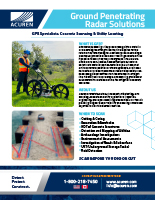Ground Penetrating Radar
 Whether it’s a standard excavation or new service installation, a geophysical map for the purposes of engineering, an environmental assessment or a search for potential burial site, Acuren is there with you. With our innovative technology and industry-leading talent, Acuren’s Ground Penetrating Radar (GPR) is the safest, quickest and most accurate method that our technicians use for locating rebar, post-tension cable, conduits, utilities, faults, and other hidden structures within concrete.
Whether it’s a standard excavation or new service installation, a geophysical map for the purposes of engineering, an environmental assessment or a search for potential burial site, Acuren is there with you. With our innovative technology and industry-leading talent, Acuren’s Ground Penetrating Radar (GPR) is the safest, quickest and most accurate method that our technicians use for locating rebar, post-tension cable, conduits, utilities, faults, and other hidden structures within concrete.
Our highly-trained technicians use the most innovative technology providing the quick and reliable results to help you make better decisions.
Our interior and exterior GPR examinations allows project pre-planning by assessing concrete in 2D & 3D formats:
Interior
- Concrete cutting / coring / drilling or demolition
- Protection / detection of concrete for embedded services
- Engineering for the purposes of concrete structure modification
- Structurally assess, map and report on both concrete structural features and reinforcement of buildings, bridges and other structures
Exterior
- Excavation
- Boreholes
- Horizontal drilling
- Water table / Aquifer / Void detection
- Geophysical / Geological mapping
- U.E. (subsurface Utility Engineering)
- Utility Damage Prevention
- Forensics investigations
- Tank detection and mapping
- Plume detection and mapping

